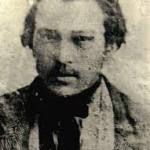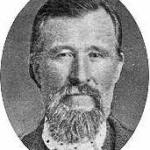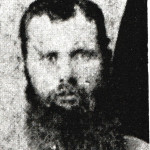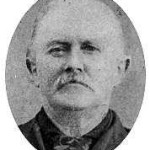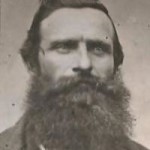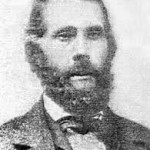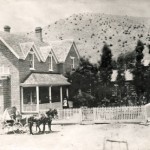
Redd house Colonia Juarez, Mexico. Courtesy of www.brimhallkerby.com
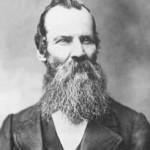
Lemuel Hardison Redd
(1836 – 1910)
Lemuel Hardison Redd, eldest son and fifth child of John Hardison and Elizabeth Hancock Redd, was born at Sneeds Ferry, Onslow County, North Carolina, July 31, 1836.
In 1839 his parents moved to Murfreesboro, Tennessee, where his father acquired a huge tobacco plantation and purchase slaves to operated it. In 1842, converted to the Gospel by John D. Lee, he was baptized into the Church of Jesus Christ of Latter-day Saints.
Becoming convinced that one man should not be in bondage to another, he freed his slaves, sold his plantation, invested the proceeds in wagons and ox teams and prepared to migrate to Zion. While these negotiations were in progress, he and his wife made a trip to Nauvoo to become acquainted with Joseph Smith. There they were given Patriarchal Blessings by Hyrum Smith.
Emigrating west they joined Captain Session’s company at the Missouri River. Lem, a boy of 14, walked and drove and ox team the entire distance to Utah. Although slight in weight and short in stature, he was agile and strong and a quick and willing worker. When cholera broke out in camp, taking the lives of many, he and his father both survived an attack. Without further incident, other than fear of Indians and of being run down by buffalo stampedes, they arrived in Salt Lake Valley in October, 1850. The family settled in Provo, then a village of some 50 families. There Lem and his sisters went to school, and one sister, Mary Catherine, died. The next year, the Redds, with William Pace and family, moved to Spanish Fork, being pioneers in its settlement. There John, the father, built the first sawmill, which was burned by hostile Indians. Soon afterward, Lem was assigned defense service against the Indians, while his father assisted in erection of a fort. This was the beginning of the Walker War.
There seem to be no time to build the rock house which John H. had in mind to duplicate his Murfreesboro home, and it was postponed. His wife Elizabeth, and his son, John Holt, both died. Soon after, his two older daughters, Moriah and Elizabeth, married Wilson D. Pace and Harvey Pace in a double wedding. Lem himself married Keziah Jane Butler, daughter of John Lowe and Caroline Skeen Butler, on January 2, 1856.
All these family changes made John’s dream house pointless and his mission to help settle the Muddy was given up. Lem, newly married and still living in the fort, was called to take his father’s place in settling the Muddy.
Members of this party were chosen with care. They were instructed on what the mission entailed and learning something of the Indian’s nature and various approaches to them. All were well supplied with guns and ammunition and instructed in self-protection. They left in the spring of 1856 and, after traveling some time but seeing no Indians, they became alarmed for they were aware of nearness by signs. Horses were driven off, and clothing and foodstuffs were stolen and unobserved moments. One Indian was seen from a distance, but he skulked out of sight. How could they make friends with such an elusive people and fulfill the mission of preaching the Gospel to them? As result, they were released and allowed to return to their homes, Lem went back to his home in the fort, and 1856 , his first son, Lemuel Hardison, Jr., was born. Life in the fort created bonds fellowship.
Relationships were cemented between the Butlers, the Paces, the Seveys, the Redds and other first settlers of Spanish Fork. John Lowe Butler was Lem’s father-in-law as well as that of George W. Sevey, who had married Keziah, Jane’s sister, Phoebe. Harvey and Wilson Pace were his brothers-in-law, and all remained firm and lifelong friends.
The year 1856 was a hard one. An epidemic of measles afflicted most of them, Lem and Keziah (Kizzie) being confined to their beds at the same time. Snow lay on the ground three and four feet deep. Canyon roads were so completely blocked that all able-bodied men were called to keep the passes open. In the snowbound state, telegrams came stating that immigrant Saints, late in beginning their trek across the plains, were starving and freezing in the mountains. Lem was chosen to go with his father and others to rescue them.
In 1858, Lem’s father was thrown from a horse and killed, leaving a young wife, Mary Lewis, and a year-old baby daughter besides his half-grown son, Benjamin. That year crops were good and life seemed propitious. But the Utah War disturbed and frighten the Saints. Lem, with about 2,000 other men, became part of a standing army detailed to do guard at mountain passes in an effort to keep Johnston’s Army from entering Salt Lake City. When the crisis was over, he settled down to help build up Spanish Fork in to a beautiful and prosperous settlement.
In 1862, a call came from President Brigham Young for settlers to go to southern Utah. Lem, the Butlers, the Seveys and Paces were among those called. By that time, Lem was the father of four children: Lem, six; Mary Jane, four; John, two; and William, a babe in arms. He sold his property, invested in teams and wagons, placed heavy machinery and furniture and a sturdy wagon, his wife and children with bedding, clothing and foodstuffs in the lighter one, and his six-year-old son, Lem, and brother, Ben, to drive the loose stock, set out for St. George. At Harmony, however where the Seveys and Paces had already located, they ended their journey and settle among relatives and acquaintances. The settlement at this time, following a washout by the “Big Storm” earlier in the year, was moving to higher ground. The storm had destroyed the fort, washed away a part of the farmland, and a New Harmony was being established 4 miles farther north. At New Harmony, they met John D. Lee, who had carried the Gospel to Lem’s parents in Kentucky, and was the founder of New Harmony.
Lem moved onto lot near the river. But not being satisfied with either the location of the house, he soon built more commodious Adobe home on higher ground in which the Redds lived for the next eight years. Here three more children are born. November 5, 1866, he entered the principle of plural marriage and married Sarah Louise Chamberlain. She was the daughter, and only child, of Solomon Chamberlain and Theresa Morse her father had crossed the plains as Brigham Young’s teamster in the original group of pioneers in 1847. Soon after this marriage, Lem bought the John D. Lee home, and unfurnished two-story building against the foothills of the Pine Mountains. John D. Lee was then a fugitive from justice as the accused leader in the Mountain Meadows massacre.
Lem and his boys finished the home and made it into a duplex with Louisa occupying the north half and Keziah the South half. Here, peaceful family living was enjoyed for 20 years and a setting was provided for a tranquil life for every child in the home. Each member willingly accepted his share of responsibilities and cooperated in the distribution of work about the house and farm. To Luisa were born 11 children and all but the two older ones, who died in infancy, were born after settling in the Lee home. To Keziah, five were born there. Life seemed good in the future bright.
All this changed, however, with the passing of anti-polygamy legislation that made polygamy a crime and everyone who entered into it a criminal. Almost overnight, their free, wholesome life was changed to one of anxiety. Plural wives were also to be arrested. A hideout for both Lem and Louisa was made in the wash behind the house, that was used many times when the approach of U.S. Marshals was suspected. In addition, Lem created reasons for being absent from home, going to and from places where businesses were created, under cover of night. He went to Mesa, Arizona, to visit his daughter, Jane, and to San Juan where he that isolated section of Utah was open for colonization. Any place where safety seemed possible he went. He served as scout for the first company that set out for San Juan by way of the Hole-in-the-Rock. Lem and three Georges – Hobbs, Morrell, and Sevey – loaded pack mules with bedding and food for eight days, and went ahead to locate a possible trail through almost impassable country to the Colorado River and beyond. The eight days stretched to 28 before they returned.
It was considered a miracle that they survived, considering the ordeals they passed through. After leaving the main company at Hole-in-the-Rock, they ferried themselves across the Colorado River. There they were confronted with many canyons leading off from the river, only one of which, of course, was the San Juan River canyon which led to the outpost for which the company was headed. Exhausting themselves and their animals by climbing the top of ridge after ridge, and further expending their strength and food on several vain searches, they finally reached a barrier through which they never could have found their way except that a mountain goat whose trail they followed led them down. Wallowing through snow drifts, have frozen and facing hunger, they made camp wondering if they could hold out until sight of the San Juan River was gained. The next morning, Lem in formed the others it if they would go with him to the top of a nearby knoll, he would show them the San Juan River just as it had appeared to him in a dream. As he predicted, there before them lay that glinting waters of the river they sought and off to the left Blue Mountain, a landmark they sought. This site was so cheering that although they had been without food for five days, they completed the journey to a log cabin on the San Juan River into which they stumbled half dead from hunger. Then, refreshed with food, they retraced their steps, marking a feasible route over Grey Mountain and delivered to the anxious Hole-in-the-Rockers the message of a possible way to reach their destination their tired bodies, weather-beaten faces and tattered clothing were mute evidence of what the information had cost.
Lem later made a trip to Bluff, after a better route had been made, on vacation with two daughters, Delle and Ellen, to help his son, Monroe, move cattle, and at the same time to dodge marshals. They had not proceeded far, however, when signs behind them indicated they were being followed. To avoid being taken by surprise, Lem slept in some hideout each night and all were on the lookout through the day. Deciding one night they had outdistance there pursuers, he began to lay out his bedroll in camp. “My second thought is that I’d better not,” and he slipped into the darkness. Ten minutes later, two marshals suddenly stepped into the firelight with a warrant for the arrest of L. H. Redd.
At Bluff, Lem found a possible place to move his wife, Louisa. For two years this to be the right decision, but marshals again put in their appearance and he realized that a better place must be found. Mexico was the place. It seemed a last resort.
In 1891, Lem loaded Louisa and her children, including baby Effie, who had been born in Bluff, but excluding Wayne, who had married, into wagons and again began the lonely trek to a foreign country. They faced water shortage in desert sections, grim fears as they passed through Indian country, and the anxiety of running out of food. They arrived in Colonia Juarez in the fall the year. There they would live the rest of their lives.
Louisa’s 13th child, Ancil, was born in the little rock house on the Alfred Baker farm above town. And her 14th, Hazel, was born in a frame house they had bought just outside town limits. Later they built a spacious, two-story brick home on the same lot. Into it the family moved. And by industry and love beautiful they made it a show place.
For the first four years, Lem’s time was divided between his home in Mexico and that the new harmony. Hectic living of the past years have allowed his Harmony farm and home to run down. Kizzie was in poor health with cancer, from which she died on May 15, 1895. Lem sold his property and interests in New Harmony and spent his entire time in Colonia Juarez, of which he and his family soon became an integral part. He acted as a High Councilman to help in the deliberations that made for the best and surest growth of the community. His children were active in school and community affairs. Life was good and free from fears of the houndings of the “underground days.”
When the Juarez Stake was first organized 1895, Lem was released from the High Council to become the First Counselor to Alexander F. McDonald, who was sustained as President of the High Priest Quorum. Shortly after, he was released and made Patriarch of the Juarez Stake of Zion. In this capacity he endeavored to give each one of his living descendants a Patriarchal Blessing before he died. In 1897, he attended the jubilee celebration of the LDS church held in Salt Lake City and connection with the October Conference. There, he visited Alice and Vilo, Kizzie’s two youngest daughters, who were attending the University of Utah, his son, Lem and daughter Hattie from San Juan, and other immediate members of his family.
In October, 1902, a memorable reunion with Kizzie’s children took place in Salt Lake City. To this gathering also went to Louisa from Mexico and her youngest child and her oldest son, Wayne. The L. H. Redd family, long separated, was able to meet for the first time since the old happy days in the John D. Lee home in New Harmony. They attended several sessions in the Salt Lake Temple together.
In March 1907, Louisa succumbed to an attack of pneumonia, her death leaving Lem bereft of a wife, with seven unmarried children, all of whom were away from home except Hazel, the youngest. Lem sold the “show place” home, and rented a house in town where he and12-year-old Hazel settled down to care for each other. It was not for long. Failing health, incident to a broken hip and advancing years, resulted in his death on June 10, 1910 at the age of 74. He was buried in Colonia Juarez Chihuahua, beside his wife Louisa. His 74 years of accomplishments, of triumphs, of hardships and of steadfastness to his church were over. Love for the Gospel was ever a dominant feature of his life, and he passed this on to his numerous posterity. Of the 21 children who survived L. H. Redd, none but have done honor to his name in this respect.
In business and the professions, his descendants have been above average in their success, public service, and loyalty to their country. In World War II, for example, his descendants served in all theaters of the war, and were a part of every division of the Armed Forces, some of them rising to the rank of Lieutenant Colonel. In all, there were 70 representatives as of his family in active duty; 21 of these were officers.
Lem with his wives, Kezziah and Louisa, may well rest in peace. Their posterity do them proud.
Nelle Spilsbury Hatch Stalwarts South of the Border pg 563

